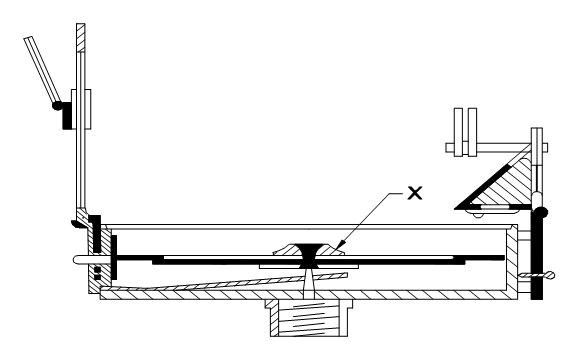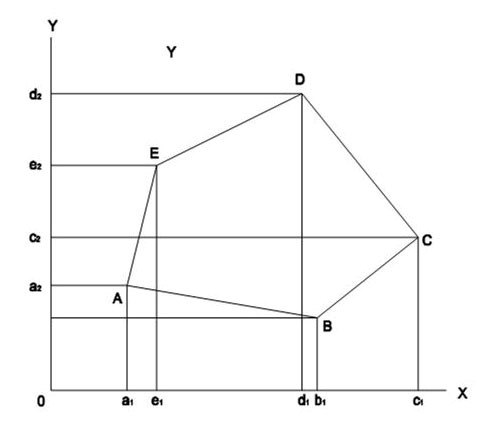Compass Surveying | कम्पास सर्वेक्षण
⬇ नीचे दिये गये START QUIZ पर क्लिक करें ⬇
Q1. How many are methods for eliminating the effects of local attractions? / स्थानीय आकर्षण के प्रभावों को समाप्त करने के लिए कितने तरीके हैं?
Q2. What is the magnetic bearing of the line, if the true bearing of a line is 225° and magnetic declination is 2° west? / लाइन का चुंबकीय बीयरिंग क्या है, अगर किसी लाइन का ट्रू बीयरिंग 225 ° और चुंबकीय ड़ेक्लिनेशन 2 ° पश्चिम है?
Q3.What is the back bearing of line PQ, if fore bearing of line PQ is 133°30ʹ? / लाइन PQ की बैक बियरिंग क्या है, यदि लाइन PQ की फॉर बियरिंग 133 ° 30 ʹहै?
Q4. What is the magnetic declination? If the magnetic and true bearing of a line are 322° 30ʹ and 319°30ʹ? / चुंबकीय डेक्लिनेशन क्या है? यदि किसी लाइन का चुंबकीय और ट्रू बीयरिंग 322 ° 30 ʹऔर 319 ° 30ʹ है?
Q5. What is the name of part in compass marked as ‘x’? / कम्पास में भाग का नाम ʹxʹ के रूप में क्या है?

Q6. Which declination direction is to be used for the - sign in magnetic bearing line? / मैग्नेटिक बेयरिंग लाइन में साइन-इन के लिए किस डेकलीनेशन दिशा का उपयोग किया जाता है?
Q7. What is the name of quadrant, if a line lies in between 180° and 270°? / क्वाड्रंट का नाम क्या है, यदि एक रेखा 180 ° और 270 ° के बीच है?
Q8. What is the rule for converting R.B to W.C.B, if a line lies in between 270° and 360°? / R.B को W.C.B में परिवर्तित करने का नियम क्या है, यदि कोई रेखा 270° से 360° के बीच है?
Q9. What is the back bearing of CD in quadrantal system, if the fore bearing of CD is S 60°30ʹ W? / क्वाड्रंटल सिस्टम में CD का बैक बेयरिंग क्या है, यदि सीडी का फ्रंट बेयरिंग S 60 ° 30 ʹW है?
Q10. What type of compass the system of graduations are marked? / ग्रेज्युएशन प्रणाली किस प्रकार के कम्पास को चिह्नित करती है?

Q11. What is the angle of QPR, if the F.B of the lines PR and PQ are N 69°00ʹ W and S 49°30ʹ W? / QPR का कोण क्या है, यदि लाइनों PR और PQ का F.B N 69 ° 00ʹ W और S 49 ° 30 ʹW है?

Q12. What is the angle BAC, if the bearings of the lines AB and AC are N25°30ʹE and S 85°30ʹE? / कोण BAC क्या है, यदि AB और AC रेखाओं की बीयरिंग N25 ° 30 ʹ E और S 85 ° 30ʹE हैं?

Q13. What is the back bearing of line PQ, if fore bearing of line PQ is 212°45ʹ? / लाइन PQ का बैक बेअरिंग क्या है, यदि लाइन PQ का फ्रंट बेयरिंग 212 ° 45 ʹहै?
Q14. Which compass the reading is taken with the help of a prism provided with the eye view? / आंख को देखने के साथ प्रदान किए गए प्रिज्म की सहायता से रीडिंग को किस कम्पास में लिया जाता है?
Q15. What is the interior angle of COB, if the bearing of OC is 135°30ʹ and OB 225°? / COB का आंतरिक कोण क्या है, अगर OC का बीयरिंग 135° 30ʹ और OB का 225° है?

Q16. Which quadrants has the numerical value of bearings increased in clock wise direction? / घड़ी की दिशा में बीयरिंगों के संख्यात्मक मान में किस चतुर्थांश में वृद्धि हुई है?
Q17. What is the rule for converting W.C.B to R.B, if a line lies in between 0° and 90°? / W.C.B को R.B में बदलने के लिए क्या नियम है, यदि कोई रेखा 0 ° और 90 ° के बीच है?
Q18. Which one of the method is more accurate in plotting a compass traverse? / कम्पास ट्रेवर्स की प्लोटिंग करने में कौन सी विधि अधिक सटीक है?
Q19. What is the system of bearing shown in figure? / चित्र में दर्शाई गई बेयरिंग सिस्टम कौनसी है?

Q20. Which variations occurred by magnetic storms? / चुंबकीय तूफानों द्वारा कौन सी विविधताएं होती हैं
Q21. What is the exact difference between fore bearing and back bearing of local attraction in a particular place? / किसी विशेष स्थान पर स्थानीय आकर्षण के फॉर और बेक बीयरिंग के बीच सटीक अंतर क्या है?
Q22. What is the rule for converting R.B to W.C.B, if a line lies in between 90° and 180°? / R.B को W.C.B में परिवर्तित करने का नियम क्या है, यदि कोई रेखा 90 ° और 180 ° के बीच है?
Q23. What represents the line OX in the figure? / आकृति में रेखा OX को क्या दर्शाता है?

Q24. What is the name of part in compass marked as ‘x’?/ कम्पास में भाग का नाम ʹxʹ के रूप में क्या है?

Q25. What is the direction of line of sight towards back bearing in surveyor compass? / सर्वेयर कम्पास में बैक बेयरिंग की दिशा की साइट क्या है?

Q26. What is the system of bearing shown in figure? / चित्र में दर्शाई गई बेयरिंग सिस्टम कौनसी है?

Q27. What is the back bearing of AB, if the fore bearing of AB is N 50°45ʹ W? | AB का बेक बीयरिंग क्या है, यदि AB का फॉर बीयरिंग N 50 ° 45 ʹW है?
Q28. What is the name of the method of plotting in compass survey? / कम्पास सर्वेक्षण में प्लोटिंग करने की विधि का क्या नाम है?

Q29. Which compass cannot be used without a tripod? / तिपाई के बिना कौन से कम्पास का उपयोग नहीं किया जा सकता है? X
Q30. What is the back bearing of AB in quadrantal system, if the fore bearing of AB is N 25°45ʹE? / चतुर्भुज प्रणाली में AB का बेक बीयरिंग क्या है, यदि AB का फॉर बीयरिंग N 25 ° 45ʹE है?
Q31. Which declination direction is to be used for the + sign in magnetic bearing line? / चुम्बकीय वहन रेखा में + चिन्ह के लिए कौन सी डेकलीनेशन दिशा का उपयोग किया जाना है?
Q32. Which compass can either be used as a hand instrument or can be fitted on a tripod? / कौन सा कम्पास या तो हाथ के साधन के रूप में इस्तेमाल किया जा सकता है या तिपाई पर फिट किया जा सकता है?
Q33. What is the name of the method of plotting in compass survey? / कम्पास सर्वेक्षण में प्लोटिंग करने की विधि का क्या नाम है?

Q34. Which compass has the graduations engraved are inverted? / किस कम्पास में उत्कीर्ण ग्रेज्युएशन उलटे होते हैं?
Q35. What is the angle of AOB, if the bearing of OA is 35° and OB is 140°00ʹ? / AOB का कोण क्या है, यदि OA का बीयरिंग 35 ° और OB 140 ° 00ʹ है?

Q36. What is the term is used for the horizontal angle with a line makes with this meridian? / इस मेरीडियन रेखा के साथ क्षैतिज कोण के लिए किस शब्द का उपयोग किया जाता है?
Q37. What is the back bearing of line AB, if fore bearing of line AB is 85°30ʹ? / यदि लाइन AB की फॉर बीयरिंग 85 ° 30 है, तो लाइन AB का बेक बीयरिंग क्या है?

Q38. What is the part of prismatic compass marked as ‘x’? / प्रिज्मीय कम्पास के भाग को? X ’के रूप में क्या कहा जाता है?

Q39. Which compass the needle also act as the index? / कौन सा कम्पास सुई सूचकांक के रूप में भी कार्य करता है?
Q40. What is the magnetic declination of the sun, if the magnetic bearing of the sun at noon is 355°? / यदि सूर्य का चुंबकीय प्रभाव दोपहर के समय 355 ° है, तो सूर्य की चुंबकीय डेकलीनेशन क्या है?

Q41. What is the inclination of the needle with the horizontal in prismatic compass? / प्रिज्मीय कम्पास में क्षैतिज के साथ सुई का झुकाव क्या है?
Q42. What is the magnetic bearing of the line, if true bearing of a line is 85° 30ʹ and the magnetic declination is 4° East? / लाइन का चुंबकीय बीयरिंग क्या है, अगर किसी लाइन का ट्रू बीयरिंग 85 ° 30 of है और चुंबकीय ड़ेक्लिनेशन 4 ° पूर्व है?
Q43. What is the name of angle ABC? / कोण ABC का नाम क्या है?

Q44. Which compass graduated ring is attached with the needle? / कौन सी कम्पास में ग्रेज्युटेड रिंग सुई के साथ जुड़ी हुई है?
Q45. What is the name of quadrant, if a line lies in between 90° and 180°? / क्वाड्रेंट का नाम क्या है, यदि कोई रेखा 90 ° और 180 ° के बीच है?
Q46. What is the term is used for the horizontal angle between a line and the true meridian? / एक लाइन और ट्रू मेरीडियन के बीच क्षैतिज कोण के लिए किस शब्द का उपयोग किया जाता है?
Q47. What is the rule for converting R.B to W.C.B, if a line lies in between 180° and 270°? / R.B को W.C.B में परिवर्तित करने के लिए क्या नियम है, यदि कोई रेखा 180° और 270° के बीच है?
Q48. What is the angle of QPR, if the bearing of PQ and QR are S70°00ʹE and S10°00ʹW? / QPR का कोण क्या है, यदि PQ और QR का बीयरिंग S70 ° 00ʹE और S10 ° 00ʹW है?

Q49. What is the name of instrument, to measure the bearing line in whole circle system? / पूरे सर्कल सिस्टम में बीयरिंग लाइन को मापने के लिए, साधन का नाम क्या है?
Q50. When is the observed bearings, corrected bearing are calculated? / कब मनाया बीयरिंग है, सही असर की गणना की जाती है?
surveyor 1st year Moudle 4 Compass Surveying
You got {{userScore}} out of {{maxScore}} correct
{{title}}
{{image}}
{{content}}